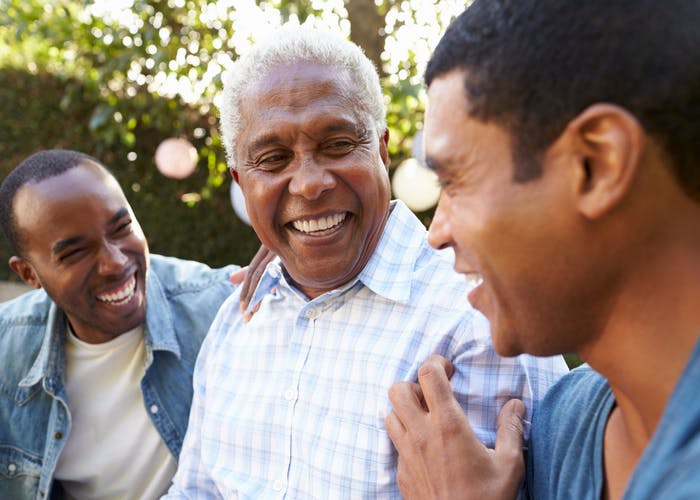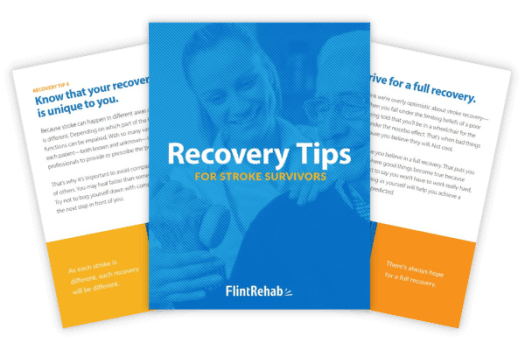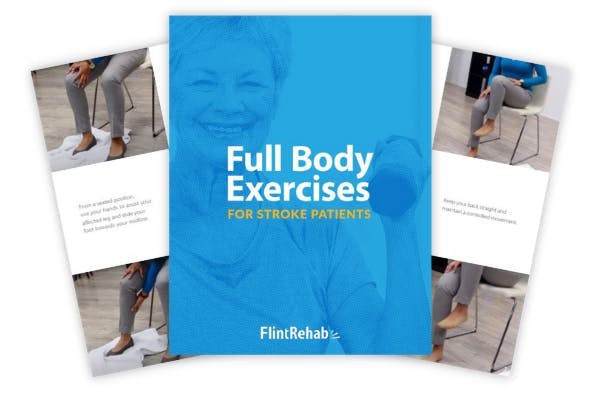No products in the cart.
No products in the cart.
No products in the cart.
No products in the cart.
Home » Neurological Recovery Blog » Stroke » How to Help Someone Who Had a Stroke: A Guide for Caregivers and Family Members
Last updated on October 16, 2023

Stroke recovery is a difficult process, and it can be hard to know how to help someone who had a stroke. It takes constant, dedicated work for survivors to regain function and independence, which can be physically and emotionally draining. That’s why it is critical for stroke survivors to have a loved one there to support them through the ups and downs of recovery.
As a family member or friend, you may be wondering how to best support your loved one as they navigate stroke recovery. While there is no cookie-cutter approach to stroke recovery support, there are several ways you can encourage and assist your loved one. In this article, we will review a few ways you can help someone who had a stroke to maximize their recovery, both physically and emotionally.
The initial stage after a stroke is often confusing and full of unknowns. This can make caring for a stroke survivor overwhelming, especially at the beginning of their recovery. Survivors and caregivers alike will go through a variety of complex emotions and even stages of grief after stroke. However, this will improve with time as you find what works best for your specific situation.
Initially, it can be hard to know how to help someone who had a stroke. To get you started on the right path, let’s review 7 tips you can use to provide extra support for your loved one.
The first step to help someone who has had a stroke is to learn more about their specific condition. A stroke occurs when an artery supplying blood to the brain becomes blocked by a clot (ischemic stroke) or bursts (hemorrhagic stroke). When blood flow in the brain is compromised, the result is tissue damage in the affected areas.
No two people are exactly alike, and no two strokes will be the same. Everyone’s brain is wired uniquely. This means your loved one’s experience will be unique, and they may not have the same stroke secondary effects as someone else.
There are many types of stroke, and the location, size, and duration of the stroke may predict the potential for recovery. Therefore, it’s beneficial to talk with your loved one’s doctor and ask about the size and location of the stroke. This information can help guide you on what the recovery journey may look like. In turn, this will allow you to help someone who had a stroke more effectively.
While it may be tempting for caregivers to help a stroke survivor with everything, this can slow their recovery process. Instead, try to assist when needed but also empower your loved one to be as independent as possible. This can help boost their recovery and may also reduce the caregiver burden.
During stroke recovery, your loved one is working on rebuilding neural pathways in their brain. By rebuilding these pathways, they can rewire lost functions to healthier, unaffected areas of the brain and regain some functional abilities. This process is known as neuroplasticity, and it’s how the brain heals from injuries such as stroke.
To maximize neuroplasticity, the survivor must engage in massed practice of therapeutic activities. For example, to relearn how to use their hands, they need to repeatedly perform hand-related activities. This includes practicing specific hand therapy exercises prescribed by their therapy team as well as participating in normal activities of daily living. If you are constantly doing everything for them, their brain will not receive the stimulation it requires, and their recovery may be limited.
As we touched on in the last section, rehab exercise is the foundation of recovery for stroke survivors. Therefore, one of the best ways to help someone who had a stroke is to encourage them to participate in therapy. For example, you can guide your loved one to do their exercises every day.
Stroke survivors who experienced a frontal lobe stroke often struggle with planning and staying on task. As a result, they may not take the initiative and do the therapy on their own. Additionally, survivors affected by depression after stroke may have difficulty finding exercise motivation.
One of the biggest reasons a survivor may experience a plateau or regression in progress after stroke is inconsistency with their rehab exercises. When a survivor is not consistently performing high repetitions of functional skills or rehab exercises, they will not notice improvement in their independence. With enough practice, however, they can increase their function and confidence.
If your loved one needs encouragement to perform their exercises, try finding ways to incorporate their hobbies or interests into their home program. Additionally, performing their exercises alongside them may help motivate them. Another helpful tool is making a daily exercise schedule. This can create more structure in their routine and can help them establish a healthy habit.
When most people think of stroke side effects, the ones that immediately come to mind are physical ones such as paralysis or slurred speech. However, many stroke symptoms are not as easily recognized. As a result, it can be tempting to think the person is fine when in fact they are not.
Fatigue, depression, anxiety, and behavior changes are all effects of stroke that can manifest in subtle ways. For example, it might look like your loved one is being inconsiderate or self-centered after stroke when in fact they are just confused. Therefore, learning the potential cognitive and behavioral secondary effects can help you better understand how to help someone who has had a stroke.
Sometimes disorders such as aphasia or dysarthria occur post-stroke, which impacts a survivor’s speech. Depending on the severity of the aphasia, your loved one may struggle to find the correct words, communicate their feelings, or comprehend what you are saying. Understandably, this can be extremely frustrating or discouraging for a stroke survivor. Additionally, this can make knowing how to help a survivor after a stroke even more challenging.
Aphasia does not mean that a stroke survivor has lost their intelligence. Rather, they have lost the ability to interpret or produce the right words. If you can remember that and make the appropriate accommodations, your interactions will be more successful.
Be patient. If your loved one has trouble understanding you, there is no need to shout. They can hear you, but they may have difficulty processing words as quickly as before. Try repeating what you said normally, allowing extra time to process, or using a different method of communication. Your survivor’s speech therapist can provide additional strategies to help both parties feel respected when communicating.
Many stroke survivors face devastating losses that can compromise their sense of freedom. This may explain why over one-third of stroke survivors experience depression at any one time.
After stroke, your loved one may express their grief in different ways. For example, they may withdraw from others or become easily frustrated. In some cases, survivors may have feelings of anger after stroke as they process the major life changes they are experiencing. Furthermore, a stroke survivor may demonstrate frequent, unpredictable mood swings.
To provide your loved one with the support they need, understand that these emotions are a normal part of the healing process. Don’t expect them to act happy or pretend as if life is the same. Instead, help them by simply being there and lending a sympathetic ear. Psychological care is also an important resource for survivors to help them identify emotions and work to process them.
You may consider taking your loved one to a stroke support group where they can talk with other survivors and vent their frustration. Caregiver support groups can also be a good option for family members and friends as well. Not only can you find helpful advice on caring for stroke survivors, but you can also meet like-minded peers who may offer you guidance and emotional support. This is a helpful tool to avoid caregiver burnout.
Stroke survivors are often faced with isolation, either from reduced mobility or post-stroke depression. However, it is important to help them stay connected to their community. Whenever someone is going through a difficult situation, the presence of close friends and family can provide needed reassurance.
Support your loved one with the best gift you can give: your relationship. Sometimes the best way to help someone who had a stroke is to simply be there. Additionally, find ways to help keep them involved with their friends, community activities, and hobbies.
As you can see, some steps for stroke recovery are not obvious. Sometimes, helping someone too much can impede their recovery. Therefore, it is important to educate yourself about stroke as much as possible. This will allow you to learn how to successfully help someone who had a stroke.
Our Stroke Recovery Blog is a great resource to learn more about the recovery process. There you can find articles for survivors and caregivers alike that encompass all aspects of the rehabilitation process.
Continue to work closely with your therapy team to gain knowledge, resources, and confidence as you navigate this journey. There is no perfect roadmap for stroke rehabilitation, so find what works best for you and your loved one as you work together toward recovery.

Get our free stroke recovery ebook by signing up below! It contains 15 tips every stroke survivor and caregiver must know. You’ll also receive our weekly Monday newsletter that contains 5 articles on stroke recovery. We will never sell your email address, and we never spam. That we promise.


Do you have these 25 pages of rehab exercises?
Get a free copy of our ebook Full Body Exercises for Stroke Patients. Click here to get instant access.
“My name is Monica Davis but the person who is using the FitMi is my husband, Jerry. I first came across FitMi on Facebook. I pondered it for nearly a year. In that time, he had PT, OT and Speech therapy, as well as vision therapy.
I got a little more serious about ordering the FitMi when that all ended 7 months after his stroke. I wish I hadn’t waited to order it. He enjoys it and it is quite a workout!
He loves it when he levels up and gets WOO HOOs! It is a wonderful product! His stroke has affected his left side. Quick medical attention, therapy and FitMi have helped him tremendously!”
FitMi is like your own personal therapist encouraging you to accomplish the high repetition of exercise needed to improve.
When you beat your high score or unlock a new exercise, FitMi provides a little “woo hoo!” as auditory feedback. It’s oddly satisfying and helps motivate you to keep up the great work.
In Jerry’s photo below, you can see him with the FitMi pucks below his feet for one of the leg exercises:
Many therapists recommend using FitMi at home between outpatient therapy visits and they are amazed by how much faster patients improve when using it.
It’s no surprise why over 14,000 OTs voted for FitMi as “Best of Show” at the annual AOTA conference; and why the #1 rehabilitation hospital in America, Shirley Ryan Ability Lab, uses FitMi with their patients.
This award-winning home therapy device is the perfect way to continue recovery from home. Read more stories and reviews by clicking the button below:
Grab a free rehab exercise ebook!
Sign up to receive a free PDF ebook with recovery exercises for stroke, traumatic brain injury, or spinal cord injury below: